
K-12 Outreach: Activities
What to do? Here are a few ideas...
Throughout the COVID-19 crisis, many of us may be stuck at home, but you've come to the right place to find fun geology themed stuff to do! Please feel free to share these differentiated geology activities and puzzles widely and make sure you check out the rest of our New Mexico Bureau of Geology webpages for more online resources: including links to fascinating geologic publications such as Lite Geology and Earth Matters with information about the amazing geology of New Mexico. You can even get out of your house with our Virtual Field Trips to take you to interesting places around New Mexico!
Rock Stories
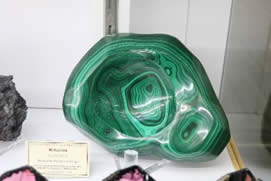
Go outside and choose a rock or find a good picture. Go online and find out about your rock. What are some of the properties of the rock that you notice, such as color, luster, if it is metallic, if it leaves a streak, and how it breaks (cleavage or fracture)? What kind of rock do you think it is? What minerals do you think are in it? How was it made? How do you think it got there?
Going further: Share the story about your rock with someone else.
Rock Sorting and ID
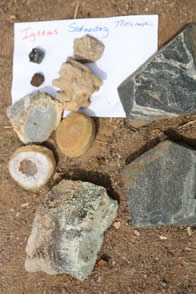
Find 10 rocks outside or online. Take a piece of paper and fold into thirds. At the top of the page you can write the way that you can sort your rocks such as: Color, Size, and Shape or Igneous, Sedimentary, and Metamorphic. Why do your rocks belong in the columns where you placed them? Ask someone if they would put the rocks in the same categories and discuss.
Going further: See if you can identify your rocks by looking for similar rocks online.
How do we use rocks? Where do these rocks come from?
How do you use rocks every day? Did you brush your teeth this morning? If you did, then you used a rock! Go online and look up how we use rocks every day and write paragraph or draw a picture (or both) to demonstrate this concept.
Going further: Where do these rocks come from? Look it up online
Measuring Rock Volume
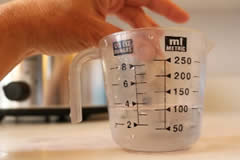
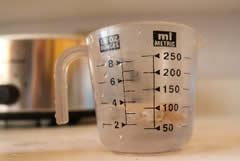
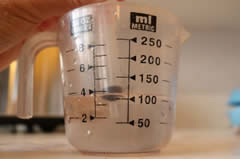
Determining rock volume with a measuring cup
How do we compare the how much space something takes up--also known as volume? One way to find out is to use a measuring cup, a syringe, and water. We can place water to a certain level in a measuring cup and take note of the beginning level. Float a small rock. (I suggest pumice, if you have it.) The amount that the water rises will tell you how much volume the rock has. Suck out the amount of water, using the syringe that rose as it was displaced by the rock. This is the rock’s volume. So if you started with 200 mL of water, you put your rock in and the water level rose to 250 mL, your rock has a volume of 50 mL. Try to float and measure the volume of different small rocks. What do you notice about the volume of the rocks you measure?
Going Further: You can also find the volume by pressing a rock all the way into clay, carefully picking the rock out of the clay, and seeing how much water will fit into the hole left by the rock. You can compare the volume of your rock when measured by the float method above to that of your clay hole measurements. When you are measuring the same rock, your measurement should be the same. Why do you think your measurements might differ? Measure the volume of multiple rocks and compare. What do you notice?
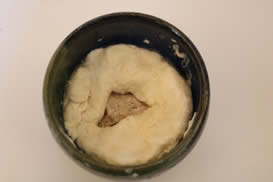

Pet Rocks (just in time to make to give for Easter!)
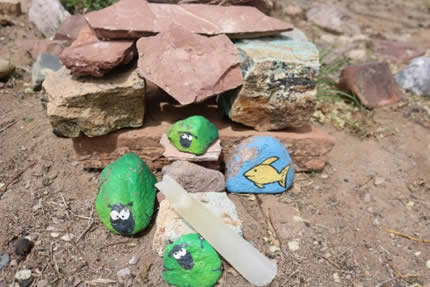
NMT Green Sheep and an aquatic friend at Maddie’s House.
Back in the 1970’s pet rocks were all the rage! You can create your own pet rock by decorating a rock with markers or paint. Name your pet rock and create a story about your new pet. Give it a personality! Here is a picture for inspiration.
Going further: What’s happening in this picture? Write or tell a story about the picture.
You may also want to:
- Check out our geological exercises & lesson plans
- View our list of web sources for geological education activities and lesson plans
- Take our virtual geologic tour of New Mexico
- Browse our frequently asked questions about New Mexico geology
- Check out the Sandia Mountain Natural History Learning Center

